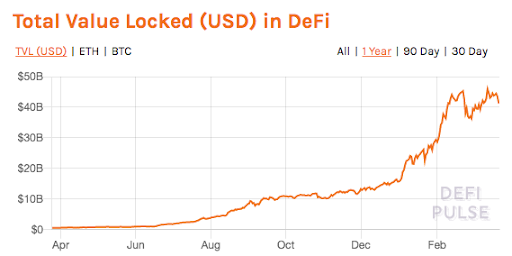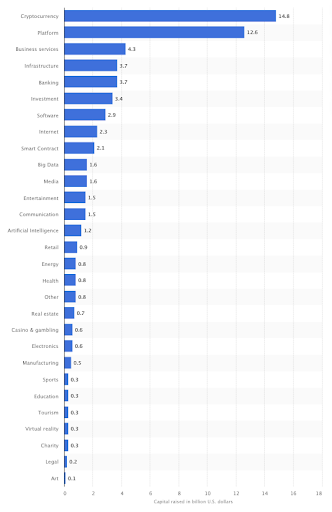It offers users the opportunity to shift some traditional financial work onto the blockchain, as well as creating entirely new applications based on the programmatic, secure and responsive nature of the blockchain, without relying on intermediaries.
While DeFi is highly experimental and fast moving, current applications include:
Yield farming
Users temporarily put their own digital assets at the disposal of others, including investors and startups, in exchange for financial rewards; a blockchain-based take on investment that happens very fast, and has the advantage over the traditional financial world that it actually generates yields.
Liquidity mining
Liquidity mining is a specific form of yield farming, in which digital asset owners provide liquidity to DEXs (Decentralized Exchanges) in return for rewards. Since DEXs historically suffered from low liquidity, this is an important development for the ecosystem as well as a major source of revenue for some digital asset investors.
How Popular is DeFi?
Google searches for the term DeFi grew 300% between March 2020 and February 2021, before falling again:

There’s another way to look at interest in DeFi: Ethereum gas fees. These rise when blocks become crowded and bidding to be including gets hot, making them a good proxy for popularity.

You can see the huge spike in 2017, where the ICO boom drove up interest in ERC-20 tokens, Ethereum-based stablecoins, and ETH — and consequently in Ethereum transactions; the price followed the numbers. Gas fees are also high and increasing for complex transactions. Currently, gas fees are hovering around the 187 gwei mark at the time of writing, though they remain quite volatile.
But you can see some differences too. The ICO boom gave us a gas price skyscraper — a single massive sharp spike surrounded by more or less flat land. The DeFi gas price boom is more sustained, and though it remains quite volatile and has never approached 2017’s giddy heights (yet), it’s consistently higher than any price of a year ago.
That’s mirrored by the flows of investment into DeFi. Right now, there is $41 billion locked up in DeFi of various types.

That’s overtaken the sums raised in ICOs:

But this chart shows the amounts raised by 2019, when the ICO boom had run for two years and many real projects had attracted significant professional and institutional investment. DeFi is still in its infancy, and its financials are still trending firmly up and to the right.
How is the DeFi boom like ICOs?
Many ICOs offered decentralized versions of use-cases that weren’t profitable in the first place or that were poor candidates for decentralization. “Blockchain” took its place alongside “AI” as a buzzword concealing bad business ideas and vaporware, tarnishing the real applications in the process. But some — the Ethereum ICO, for instance — were real investment opportunities, and blockchain technology was at the core of the business, not levered in afterwards.
DeFi and ICOs also both had the effect of reducing the amount of ETH in circulation and driving up gas prices. Some ICOs were held off Ethereum, and there are promising non-Ethereum projects like Polkadot/Solana for DeFi, but the standard blockchain for financial transactions and smart contracts remains Ethereum.
Ethereum is particularly well suited because it offers “composability” — the ability to treat applications like “Lego” that can be combined easily with any other application like building blocks. That combination can be packaged and resold, or users can simply move seamlessly from selecting investment opportunities to making investments to withdrawing their profits. Where this can’t be done, friction enters the system, transaction costs and times rise, users fall away and the ecosystem’s growth is lessened. Composability was a key concern for ICOs, but it’s far more important for DeFi, which is dependent for profitability on complex networks of transactions.
Crucially, regardless of the specific underlying technology, DeFi and ICOs are both ways to make money on the blockchain.
We reached out to Alameda Research co-founder and CEO Sam Bankman-Fried, who told us:
“There are definitely some similarities: yet-another-DeFi-token that just dumps and walks away with no actual project bears a lot of resemblance to some of the more unseemly 2017 ICOs, and in both cases hype has gotten way ahead of actual use cases.”
But there are important differences.
One is that many, if not most, ICOs turned out to be securities sales on closer inspection; when the SEC did inspect them closely, it came down on them hard, regulating ICO profitability out of existence as well as wiping out the ICO-fraud market.
An ICO works like this: You buy tokens for a project that hasn’t started making money yet. When it does, it buys your tokens for the project’s digital asset which you can then spend, trade or “cash in” for fiat currency. It’s easy to see how that’s a security, but you can also see how it leaves investors in a relatively powerless position. You hand over money, the project goes away, and hopefully comes back with some more money. As an investor you don’t have much control.
By comparison, DeFi projects leave investors with much more access to the levers. DeFi tokens are typically offered in exchange for “work” or “services”, giving investors a lot more direct control. You can choose where to allocate resources and directly manage your investments.
In addition, DeFi isn’t going to face the same regulatory impact as ICOs. It will definitely face some — any new industry that attracts billions of dollars in investment will face some regulatory scrutiny — but it won’t be the SEC going after DeFi projects as illegal securities traders.
Finally, while there is hype around DeFi, there’s also a lot of real money being made day-to-day by investors. And there are a lot more projects where decentralization brings real benefits, as with decentralized derivatives exchange Serum, which offers sub-second transaction speeds for fractions of a penny and a fully on-chain orderbook — hard things for traditional finance to compete with.
Sam Bankman-Fried again:
“I think that there’s probably more real stuff going on in DeFi than in 2017 — some of it is really cool and potentially useful! But it’s a mixed bag.”
ICOs were a mixed bag too, and they’re remembered as an empty, profitless bubble; but that’s inaccurate. Three of the top 10 ICOs from the 2017 boom now have more liquid assets than their market cap — not the mark of an overstretched, failing business.
